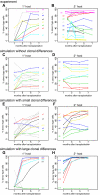Characterization and quantification of clonal heterogeneity among hematopoietic stem cells: a model-based approach
- PMID: 18809760
- PMCID: PMC2597595
- DOI: 10.1182/blood-2008-05-155374
Characterization and quantification of clonal heterogeneity among hematopoietic stem cells: a model-based approach
Abstract
Hematopoietic stem cells (HSCs) show pronounced heterogeneity in self-renewal and differentiation behavior, which is reflected in their repopulation kinetics. Here, a single-cell-based mathematical model of HSC organization is used to examine the basis of HSC heterogeneity. Our modeling results, which are based on the analysis of limiting dilution competitive repopulation experiments in mice, demonstrate that small quantitative but clonally fixed differences of cellular properties are necessary and sufficient to account for the observed functional heterogeneity. The model predicts, and experimental data validate, that competitive pressures will amplify small clonal differences into large changes in the number of differentiated progeny. We further predict that the repertoire of HSC clones will evolve over time. Last, our results suggest that larger differences in cellular properties have to be assumed to account for genetically determined differences in HSC behavior as observed in different inbred mice strains. The model provides comprehensive systemic and quantitative insights into the clonal heterogeneity among HSCs with potential applications in predicting the behavior of malignant and/or genetically modified cells.
Figures






Similar articles
-
Deterministic regulation of hematopoietic stem cell self-renewal and differentiation.Blood. 2002 Aug 15;100(4):1302-9. Blood. 2002. PMID: 12149211
-
Predicting clonal self-renewal and extinction of hematopoietic stem cells.Proc Natl Acad Sci U S A. 2011 Mar 15;108(11):4370-5. doi: 10.1073/pnas.1011414108. Epub 2011 Feb 28. Proc Natl Acad Sci U S A. 2011. PMID: 21368169 Free PMC article.
-
Clonal analysis of thymus-repopulating cells presents direct evidence for self-renewal division of human hematopoietic stem cells.Blood. 2006 Oct 1;108(7):2446-54. doi: 10.1182/blood-2006-02-002204. Epub 2006 Jun 6. Blood. 2006. PMID: 16757689
-
Hematopoietic stem cell heterogeneity takes center stage.Cell Stem Cell. 2012 Jun 14;10(6):690-697. doi: 10.1016/j.stem.2012.05.006. Cell Stem Cell. 2012. PMID: 22704509 Review.
-
In-vivo differentiation of adult hematopoietic stem cells from a single-cell point of view.Curr Opin Hematol. 2020 Jul;27(4):241-247. doi: 10.1097/MOH.0000000000000587. Curr Opin Hematol. 2020. PMID: 32398457 Review.
Cited by
-
Cell-cell interaction networks regulate blood stem and progenitor cell fate.Mol Syst Biol. 2009;5:293. doi: 10.1038/msb.2009.49. Epub 2009 Jul 28. Mol Syst Biol. 2009. PMID: 19638974 Free PMC article.
-
Differential response to cytotoxic therapy explains treatment dynamics of acute myeloid leukaemia patients: insights from a mathematical modelling approach.J R Soc Interface. 2020 Sep;17(170):20200091. doi: 10.1098/rsif.2020.0091. Epub 2020 Sep 9. J R Soc Interface. 2020. PMID: 32900301 Free PMC article.
-
Clonal hematopoiesis of indeterminate potential and its impact on patient trajectories after stem cell transplantation.PLoS Comput Biol. 2019 Apr 26;15(4):e1006913. doi: 10.1371/journal.pcbi.1006913. eCollection 2019 Apr. PLoS Comput Biol. 2019. PMID: 31026273 Free PMC article.
-
Accumulation of 4-1BBL+ B cells in the elderly induces the generation of granzyme-B+ CD8+ T cells with potential antitumor activity.Blood. 2014 Aug 28;124(9):1450-9. doi: 10.1182/blood-2014-03-563940. Epub 2014 Jul 18. Blood. 2014. PMID: 25037628 Free PMC article.
-
Distinct hematopoietic stem cell subtypes are differentially regulated by TGF-beta1.Cell Stem Cell. 2010 Mar 5;6(3):265-78. doi: 10.1016/j.stem.2010.02.002. Cell Stem Cell. 2010. PMID: 20207229 Free PMC article.
References
-
- Devine H, DeMeyer E. Hematopoietic cell transplantation in the treatment of leukemia. Semin Oncol Nurs. 2003;19:118–132. - PubMed
-
- Klein C, Baum C. Gene therapy for inherited disorders of haematopoietic cells. Hematol J. 2004;5:103–111. - PubMed
-
- Quesenberry P, Habibian H, Dooner M, et al. Physical and physiological plasticity of hematopoietic stem cells. Blood Cell Mol Dis. 2001;27:934–937. - PubMed
-
- Down JD, Boudewijn A, Os Rv Thames HD, Ploemacher RE. Variations in radiation sensitivity and repair among different hematopoietic stem cell subsets following fractionated irradiation. Blood. 1995;86:122–127. - PubMed
Publication types
MeSH terms
Grants and funding
LinkOut - more resources
Full Text Sources
Medical

